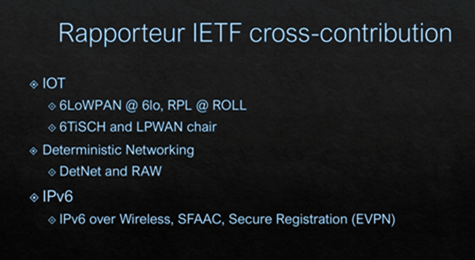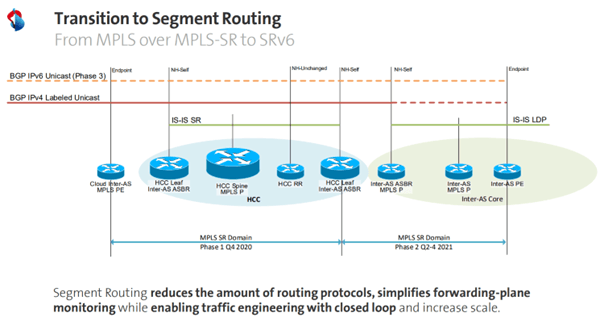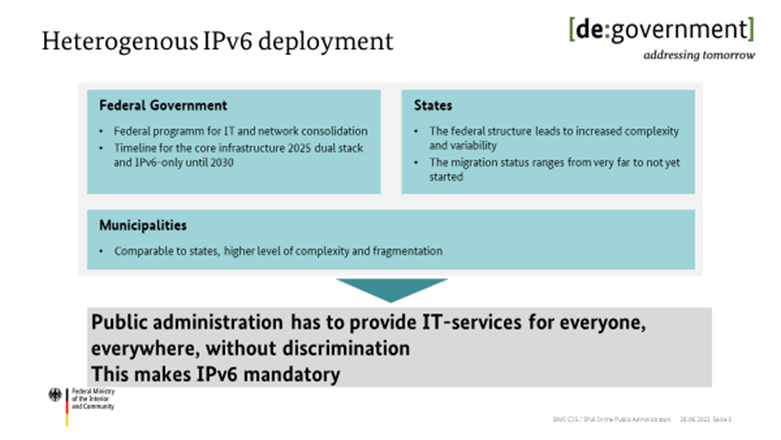ETSI IPv6 Enhanced innovation (ISG IPE) reinforces its role in industry and reaches 100 members/participants at IPE#07
Industry Specification Group (ISG) IPv6 Enhanced innovation (IPE) held its 7th plenary on 28 June 2022.
The current focus of the ISG is twofold: to publish best practices guidelines, to provide and demonstrate PoCs / test case descriptions to support innovation on IPv6 networking topics and validate standards-based approaches, whilst working on “IPv6 networking e2e reference architecture" spanning multiple IETF areas and defined protocols.
ISG IPE is steadily growing its membership passing 100 to become one of the largest ETSI ISGs in terms of members/participants. Many operators including AirLAN, Entel Chile, Megacable Holdings, Personal Paraguay, Sky Italia, Swisscom and Totalplay Comunicaciones recently joined, reaching 23 global operators involved. This testifies the need for operators to define IP transport strategy and confront within the industry on evolution guidelines.
Pascal Thubert (Cisco Systems France), chair of 2 IETF WGs and co-author of more than 20 IETF RFCs, highlighted the scope and values of ISG IPE:
- IPE provides best practices and does not work on protocol specification. IPE is not competing with the IETF. All the functionalities under discussion come from the IETF.
- The best way to grant alignment across standards body is the cross-participation and cross-contribution of multiple members of both SDOs. The IETF uses liaison statements to solve issues rather than day-to-day work, and limits the number of liaisons it maintains.
- Many rapporteurs and contributors in IPE are also heavily involved and contribute to the IETF, granting the above cross-contribution alignment with IETF standards. An example being Work Item DGR/IPE-004 on IPv6 based enterprise networking and Industrial Internet for which Pascal is the Rapporteur, includes several references to IETF standards.
- There are references to the following protocols: DHCPv6, IPv6 ND and ND proxy, SRv6, SAVI, ANIMA, RAW and DetNet architecture, 464 XLAT.

IPE#07 began with 2 presentations.
Firstly Thomas Graf (Swisscom), a new ISG member who presented the IPv6 and SRv6 migration experience from MPLS and the future plans within Swisscom:
- He explained the various phases of the process, from MPLS to SR-MPLS and finally to SRv6.
- He highlighted how the best practices for the monitoring and operation of the new technologies are essential in the deployment of new technologies and in the operational phases. He highlighted best practices for SRv6 monitoring and troubleshooting, with the perspective of introducing full blown digital twin system based on Yang model to go towards network automation and intent based management.
- SRv6 has been highlighted as a protocol able to substitute many others, simplifying the network and resulting to be a key enabler for automation. The flexible VPN service delivered to the customer on top of SRv6 benefit as well from the advanced monitoring system, able to detect root cause of faults in extremely precise and effective way.
The second presentation was given by ISG Guest Constanze Buerger, Director at the German Federal Ministry of Interior (Bunderministerium des Innern und für Heimat (BMI)). Constanze provided an insight into the IPv6 transition status in public administration and future perspectives:
- The initial push to the IPv6 transition ignited from the consideration that public administration has to provide IT-services for everyone, everywhere, without discrimination. This has made IPv6 mandatory. IPv6 leads to new fields of action in the standardization of IT networks for regulatory authorities as well as administration and politics.
- Proper coordination and central planning are needed to effectively transition the Public Administration infrastructure and services to IPv6. Guidelines, architecture and IPv6 Address Planning have to be defined centrally and provided for local actuation, with the proper level of flexibility to each entity.
- A whole /23 subnet has been allocated to Germany for Public Administration, making the German Government a Local Internet Registry (LIR). To have a fully owned IPv6 network is guaranteeing sovereignty and independence from providers.
- The current challenging goal is to evolve 80% of the core infrastructure to IPv6-Only by 2030. IPv6 is a technical, organizational and political issue. It requires a full reorganization of the IT management team and of the network knowledge. The goal for a Sovereign, Scalable and Secure infrastructure has been achieved in this way.
- Together with other IPE members involved in public policies definitions, a group report on IPv6 transition guidelines for governments will be delivered.
IPE has recently published two Group Reports:
- GR IPE 002 - IPv6 based Datacenters, Network and Cloud Integration
- GR IPE 005 - 5G Transport over IPv6 and SRv6
The status of each active work item was also reviewed at IPE#07:
- DGR/IPE-003 IPv6 Only – version 0.0.3 Early draft
- DGR/IPE-004 IPv6 based enterprise networking and Industrial Internet Stable draft
- DGR/IPE-006 IPv6-based DataBlockMatrix - version 0.0.12 Final draft for approval
- DGR/IPE-007 IPv6-based 5G for CAM – version 0.0.2 Early draft
- DGR/IPE-008 IoT & 6TiSCH - version 0.0.2 Stable draft
- DGR/IPE-009 SRv6 based SFC - ISG approved, pending publication
- DGR/IPE-010 IPE Proof of Concepts Framework - ISG approved, pending publication
- DGR/IPE-011 IPv6-based ROOTSERVER - Early draft
- DGR/IPE-012 IPv6-based Blockchain – Final draft for approval
- DGR/IPE-013 Implementing CGA for IPv6 - Early draft
ISG IPE will hold 2 webinars on 1 and 2 September focusing on IPv6 real case scenario applications and IPE deliverables main outcomes:
Part 1: IPE IPv6 Enhanced-innovation-global-vision Part-1
Part 2: IPE IPv6 Enhanced innovation-major-industry-scenarios Part-2
For further information see the ISG IPE committee page or contact ISGsupport@etsi.org



